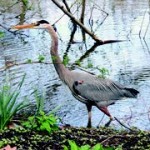↓ Download Brochure & Trail Guide (PDF)
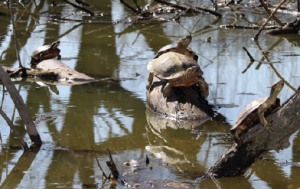
The Wetland Bridge and Pond Overlook
The boardwalk crosses a shallow wetland that was created during the 2001 restoration. The wetland helps filter and clean the water in the pond, both by settling and by the action of the plants. Among the wetland plants are Pickerel Weed, with heart-shaped leaves and spikes of blue flowers, and Arrowhead, also called “duck potato”, with arrow–shaped leaves and white flowers. Tiny floating Duckweed plants sometimes cover the water. The pond overlook provides a full view of the pond, where Painted Turtles bask on logs or slip into the water as people approach. Cormorants and heron hunt for fish and small invertebrates from the pond.
Please don’t feed the ducks, fish, squirrels, birds or any of the animals at Hall’s Pond. Wild creatures need to find their own natural food; human food can harm them and also degrades the water quality.
The South Entrance
This gate opens to a grassy area and the formal garden. Although landscaped, these areas are not park land. Rather, they are significant parts of the sanctuary, providing open space and habitat for diverse species.

The Pond
Two large fallen willow trunks serve as seating at the edge of the pond. Dragonflies, Water Striders and Whirligig Beetles patrol the water. Other insects and invertebrates swim below the surface. Small native fish are present in the pond. The large fish that can be seen just below the surface are carp. These non-native fish tend to crowd out other species. Because they stir up mud from the pond bottom, the sunlight and oxygen available for plants and other animals is decreased. A cluster of native moisture-loving plants grows at the edge of the pond, including Red-twig Dogwood, Alder, and tall, reedy-looking Cattails.
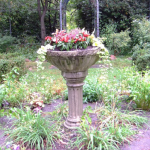 The Formal Garden
The Formal Garden
An arched trellis leads to the formal garden. This garden has been tended for 25 years by the Friends of Hall’s Pond, founded by Josephine Albrecht, to whom the nearby granite bench is dedicated. Many of the garden shrubs are native, including Shadbush, Witch Hazel and Mountain Laurel. Native flowering perennials include Butterfly Milkweed, New England Aster and Snakeroot. The garden provides food and shelter for a variety of animals, including hummingbirds, butterflies, and garter snakes.
The Viewing Platform
A short spur of boardwalk leads to the viewing platform. Poison ivy grows luxuriantly under the boardwalk and up the trees. People can develop a rash from touching this plant, even in winter, but many other animals are not allergic to it. Birds and mice eat the white berries soon after they ripen. Willows dangle long yellow twigs over the water. Great blue heron, Black-crowned Night-Heron, and Green Heron sometimes hunt food in this sheltered section.
The Wooded Wetland
Between the pond and the upland path is a wooded wetland, where trees grow on mounds of soil and water collects during wet seasons. Peat soil lies under the area. As this material decomposes, it releases natural oils as well as nutrients needed by small organisms. This oil on the water may look like pollution, but it is not.
The Upland
A side trail to the right loops through the upland area of the Sanctuary. Hall’s Pond Sanctuary is so small that its plant communities cannot readily re-establish themselves if they are seriously damaged. During the 1980’s and 90’s, non-native vines that had escaped cultivation–Porcelain Berry, Oriental Bittersweet, and Multiflora Rose—decimated the native trees, leaving no possibility that the woods could overcome them and regenerate.
Native shrubs and small trees were planted here as part of the renewal project. When they become established, they will naturalize and provide appropriate food and shelter for diverse native animals.
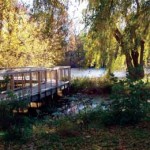
The Boardwalk Around The Pond
The boardwalk circling the pond allows access to visitors while minimizing soil compaction and damage to the plants. Cherry saplings, Cat brier and Sweet Pepperbush grow thickly here. Birds hide among them and insects nibble the leaves, flowers, and fruit.
Silver Maples, which stand along the north bank of the pond, reach great size. A major section broke off one of these maples during a storm, splitting its hollow trunk. The closet-sized cavity in the trunk can be seen from the boardwalk. As the fallen part of the tree decays, it will fertilize the soil and provide necessary habitat for a complex community of animals.
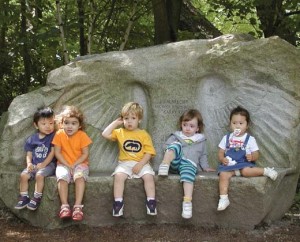
Jo Albrecht’s ‘Angel‘
Josephine J, Albrecht
1907-1994
Throughout work on this plan there has been the spirit of one who set the standards, set the pace, and set an example for us over nearly 20 years at Hall’s Pond Sanctuary, Jo Albrecht’s memory and inspiration continue to guide us as we try to fill the great void her death has left. This plan is an outgrowth of our commitment to what Jo Albrecht and the Friends of Hall’s Pond have begun. It institutionalizes stewardship policies which will ensure a stable future for a fragile resource. We know Jo would be honored by this work and its plan for her most precious place.
Brookline Conservation Commission
Friends of Hall’s Pond
Jean Densmore Bench
In 2002, the family of Jean Densmore donated a bench in her memory, which is both an attractive feature and a welcome amenity for both viewing and enjoying the garden.
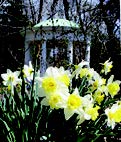 Amory Woods
Amory Woods
The gazebo and naturalized garden plants are relics of private gardens. Over time, trees and shrubs over-ran the gardens, creating a small woodland. In the center is an exceptionally large Northern Red Oak, with a 54-inch diameter and a 60-foot spread.
Blue Jays, crows, hawks, wrens and robins frequent Amory Woods throughout the year, and migrating warblers appear in May and September. Squirrels are active by day, skunks and racoons by night.

